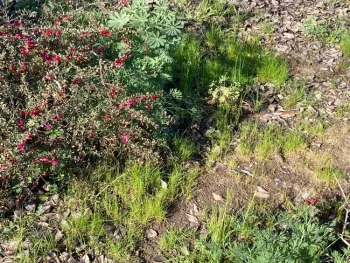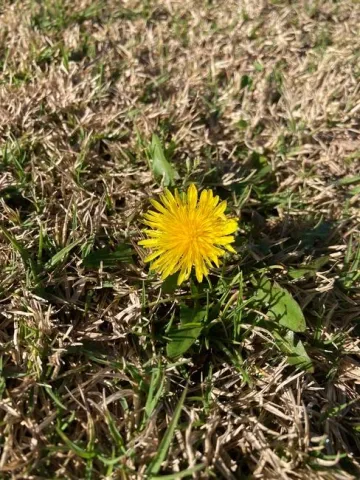
Weeds present a serious economic problem for farmers, a major headache for vegetable gardeners, and an unattractive appearance in landscapes, but herbicides are not the only solution.
“Studies have shown that more than 70 percent of weeds in lawns and ornamental plantings can be controlled based on good cultural practices,” said Dr. Clebson G. Gonçalves, a horticulture expert and farm advisor with UC Cooperative Extension in Lake and Mendocino counties. He spoke about springtime weed identification and management during a recent urban horticulture webinar offered by the UC Integrated Pest Management Program. “To control weeds, start with good soil; choose suitable plants; and mow, prune, water, and control pests to ensure dense and healthy turf and ornamentals.”
There are several definitions for the term “weeds,” but generally speaking, it can be defined as a plant out of place. Gonçalves used common bermudagrass as an example.
“Bermudagrass is one of the most desirable grass species for golf courses, sports fields, and residential lawns. But out of place, it's extremely difficult to control. It's adaptable to a wide range of environments and can reproduce by rhizome, stolon, and seeds,” he said.

When deciding how to control weeds in lawns and landscapes, Gonçalves suggests gardeners start by identifying the species. The Weed Research and Information Center at the University of California, Davis, offers a free online weed identification tool. Users input characteristics of the weeds – such as weed type (grasslike, broadleaf, woody), where the weed was found, leaf characteristics, stem characteristics, floral characteristics, life cycle, growth habit, etc. – and the tool offers potential species. The UC IPM Program maintains a weed photo gallery of species commonly found in California.
Knowing the species helps determine best practices for control. For example, nutsedge is a grass-like weed that develops nut-like tubers on the roots. The tubers are key to nutsedge survival. Dig deeply into the soil to remove the tubers on mature nutsedge roots. To limit tuber production, remove small nutsedge plants before they have 5 to 6 leaves.
Gonçalves suggests following the principles of integrated pest management to control the weeds by first considering practices that are effective and environmentally sound.
Preventative
- Avoid bringing weeds into your garden and landscape in the first place. Gonçalves suggests using weed-free soil and compost. “It's better to spend a little more money up front when you buy topsoil and compost, than spending even more money later for weed control,” he said.
- Inspect plants at nurseries before bringing them home to see if there are any weeds in or under the pot.
- Clean the mower between lawns. “This is especially important for landscaping companies that work in different locations on the same day. It is important to clean all the equipment before starting in a different location.,” Gonçalves said.
- Never let weeds go to seed. “A lot of species – such as dandelions, bermudagrass, and annual bluegrass – can produce a new seed head very quickly,” Gonçalves said. “If you mow every other week, that's enough time for these weeds to produce new seed heads and disperse seeds. It's better to mow once a week or even more often to prevent the production of seed.”
Cultural
- Soil aeration. “It's very important to alleviate soil compaction in established turf. You will have better water infiltration, greater nutrient availability and more oxygen underground, which promotes plant health and growth above and below the ground,” Gonçalves said.
- Don't leave soil exposed. Limit the area for weeds to grow by utilizing dense plantings. “When you have light and moisture, you have weeds coming up,” he said.
- Mow uniformly at a height of three inches or more. The tall and dense turfgrass canopy will shade the ground and prevent the germination of several weed species.
- Fertilize uniformly.
Mechanical
- Pulling weeds. “Every weed can be controlled by hand. If you have the time to pull by hand, that is recommended. There is some pleasure in pulling weeds. It can be used as therapy,” Gonçalves said.
- Mulches. Wood chips, stone, leaves or compost – especially on top of landscape fabric – can control weeds.
- Flaming. Very effective, primarily in the early stages when weeds are small in stature. But if they are aggressive weeds with strong taproots, such as dandelions and buckhorn plantain, they can grow back very quickly.
Herbicides
- Organic. Always use certified products. “Don't make homemade herbicides. They are still pesticides and can be dangerous,” Gonçalves said. Corn gluten meal is the only organic pre-emergent herbicide. Organic herbicides are available for consumers in different combinations and concentrations. “Vinegar-based herbicides can be very expensive, but other options such as citric acid-based, caprylic acid-based, clove-oil-based, or ammonium nonanoate-based can be more affordable and provide vinegar-like weed control,” Gonçalves said.
- Synthetic. “Many synthetic herbicides also are available for consumers. But the question is: Do you need it? Keep in mind that, all options presented above must be considered first before deciding to use herbicides,” Gonçalves said.
- In both cases, synthetic and organic herbicides are pesticides. Carefully read and follow the label directions.
Learn more:
UC Weed Research Information Center
UC Integrated Pest Management Program



